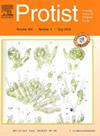The enigmatic genus Malacophrys Kahl, 1926 (Ciliophora: Intramacronucleata) belongs to the class Oligohymenophorea
IF 2.1
3区 生物学
Q4 MICROBIOLOGY
引用次数: 0
Abstract
The ciliate genus Malacophrys has been incertae sedis for more than 50 years in what is now subphylum Intramacronucleata, provisionally assigned to three different classes by various authors. Of the three species included in the genus, M. sphagni and the type species, Malacophrys rotans, have not been studied by modern methods and M. viridis, although morphologically well-described, lacks molecular characterization. We identified two freshwater ciliates as morphologically consistent with two members of Malacophrys, namely M. rotans and M. viridis. We studied one population of M. rotans, using in vivo observation and silver carbonate and silver nitrate impregnation, and two populations of M. viridis, using in vivo observation, silver carbonate impregnation, and 18S rRNA gene sequencing. Phylogenetic analyses strongly support the position of M. viridis in the class Oligohymenophorea. Morphologic features suggest Malacophrys rotans belongs to order Tetrahymenida, but a confident phylogenetic assignment awaits its molecular sequencing. Differences between their oral structures and silverline patterns indicate that M. rotans and M. viridis likely belong to different genera. A formal separation at the genus level awaits molecular characterization of the type species, M. rotans.
谜一般的Malacophrys Kahl属,1926(栉蚜目:内层栉蚜目)属于少膜蜂目
纤毛虫属(Malacophrys)在现在的甲壳内亚门(amamucleata亚门)中被划分为三个不同的纲已有50多年的历史。在该属的三个物种中,M. sphagni和模式种Malacophrys rotans尚未用现代方法进行研究,M. viridis虽然在形态学上描述得很好,但缺乏分子表征。我们鉴定了两种淡水纤毛虫,它们在形态上与线虫的两个成员一致,即M. rotans和M. viridis。本研究采用体内观察、碳酸银浸渍和硝酸银浸渍的方法研究了一个鹿角支原体种群,采用体内观察、碳酸银浸渍和18S rRNA基因测序的方法研究了两个绿芽孢支原体种群。系统发育分析有力地支持了紫茧蜂在低膜蜂亚纲中的地位。形态特征表明,黄毛线虫属于四膜目,但一个自信的系统发育分配等待它的分子测序。它们的口腔结构和银线模式的差异表明,轮状分枝杆菌和绿芽孢杆菌可能属于不同的属。在属水平上的正式分离等待模式物种M. rotans的分子表征。
本文章由计算机程序翻译,如有差异,请以英文原文为准。
求助全文
约1分钟内获得全文
求助全文
来源期刊

Protist
生物-微生物学
CiteScore
3.60
自引率
4.00%
发文量
43
审稿时长
18.7 weeks
期刊介绍:
Protist is the international forum for reporting substantial and novel findings in any area of research on protists. The criteria for acceptance of manuscripts are scientific excellence, significance, and interest for a broad readership. Suitable subject areas include: molecular, cell and developmental biology, biochemistry, systematics and phylogeny, and ecology of protists. Both autotrophic and heterotrophic protists as well as parasites are covered. The journal publishes original papers, short historical perspectives and includes a news and views section.
 求助内容:
求助内容: 应助结果提醒方式:
应助结果提醒方式:


